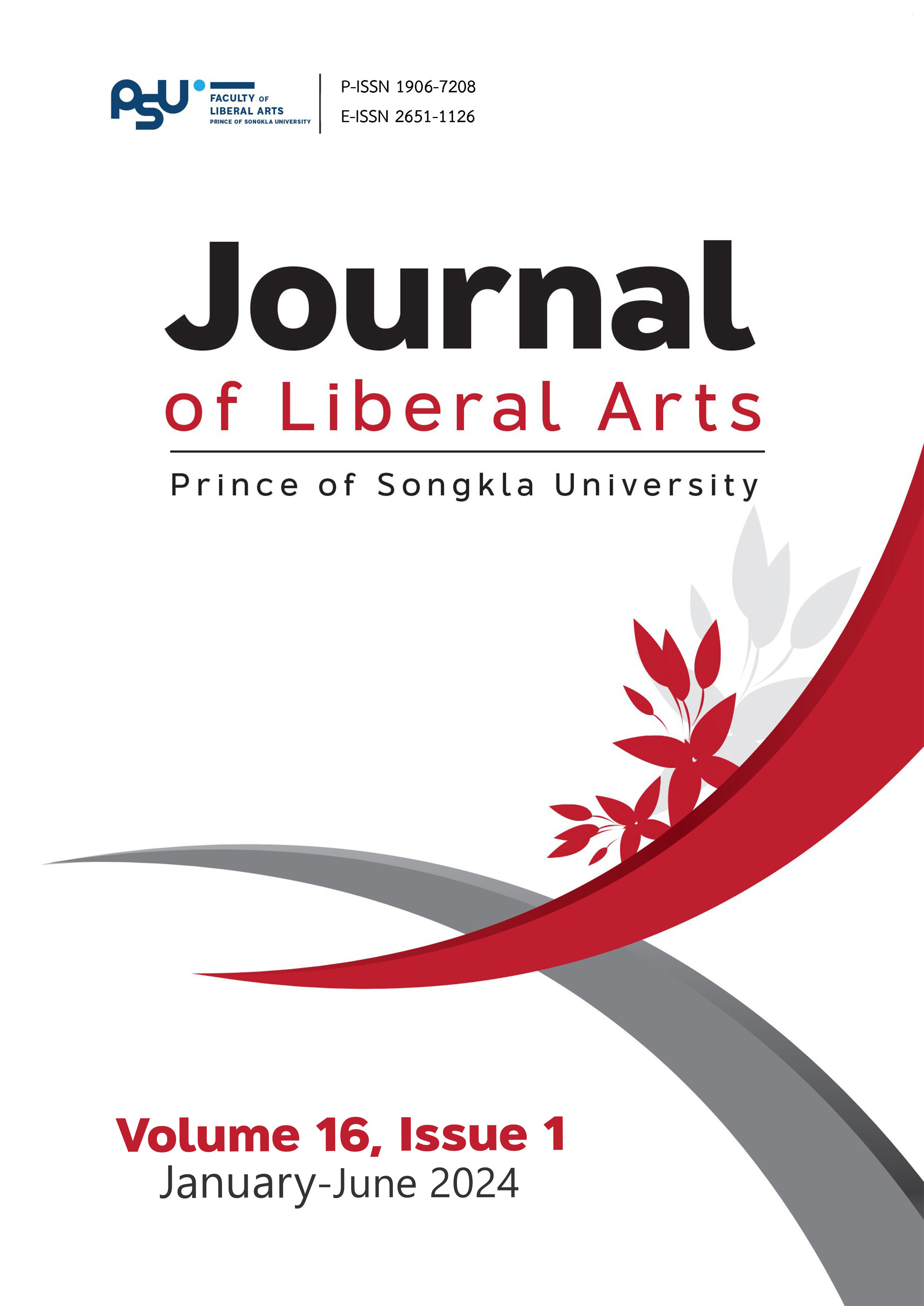การเปรียบเทียบประสิทธิภาพการแปลของโปรแกรม Google Translate ระหว่างปี ค.ศ.2018 และค.ศ.2023
DOI:
https://doi.org/10.14456/jlapsu.2024.5คำสำคัญ:
การแปลจากโปรแกรม Google Translate , การแปล , ข้อผิดพลาดด้านคำศัพท์, ข้อผิดพลาดด้านวากยสัมพันธ์, ข้อผิดพลาดด้านวาทกรรมบทคัดย่อ
Google Translate ได้พัฒนามาเป็นเครื่องมือสำหรับผู้อ่านที่ต้องการทำความเข้าใจภาษาอังกฤษ การแปลของตัวเครื่องมือแม้ไม่ได้สมบูรณ์นักแต่มีคุณสมบัติที่เป็นประโยชน์ที่ช่วยให้ผู้อ่านเข้าใจความหมายโดยภาพรวมได้ นอกจากนี้เครื่องมือยังได้รับการพัฒนาและยังมีการศึกษาเพื่อพัฒนาระบบอย่างต่อเนื่อง บทความวิจัยนี้มีวัตถุประสงค์ เพื่อเปรียบเทียบข้อผิดพลาดในการแปลด้วยเครื่องของ Google Translate ในบทความข่าวออนไลน์ สองบทความซึ่งนำมาจากหนังสือพิมพ์ในปี 2018 และ 2023 และบทอ่านระดับเริ่มต้น 1 บทความ ที่แปลจากภาษาอังกฤษเป็นภาษาไทย การวิเคราะห์ข้อมูลใช้วิธีการเชิงคุณภาพและเชิงปริมาณเพื่อระบุข้อผิดพลาดที่เกิดจากการแปลของ Google Translate ผลจากการศึกษาครั้งนี้ชี้ให้เห็นข้อผิดพลาดในการแปลของระบบการแปล Google Translate โดยแบ่งออกได้เป็นสามประเภทหลักได้แก่ คำศัพท์ วากยสัมพันธ์ และวาทกรรม ในข้อความที่แปลทั้งในปี 2018 และ 2023 โดย ในปี 2018 ความถี่ของข้อผิดพลาดทั้งหมด คือ 87% และลดลงเป็น 39% ในปี 2023 จากข้อผิดพลาดทั้งหมด Google Translate มีข้อผิดพลาดด้านคำศัพท์ในปี 2018 คิดเป็น 55% ข้อผิดพลาดทางวากยสัมพันธ์ 30% และข้อผิดพลาดในด้านวาทกรรม 20%
ในปี 2023 ได้มีการปรับปรุงอัตราข้อผิดพลาด โดยข้อผิดพลาดด้านคำศัพท์ลดลงเหลือ 25% ข้อผิดพลาดทางวากยสัมพันธ์เหลือ 10% และข้อผิดพลาดวาทกรรมเหลือ 10% ซึ่งชี้ให้เห็นถึงผลการพัฒนาระบบในระหว่างช่วงครึ่งทศวรรษที่ผ่านมา แม้จะมีข้อผิดพลาดเกิดขึ้นในหลายจุด แต่การศึกษานี้มุ่งที่จะให้คำอธิบายและแนวทางปฏิบัติเพื่อปรับปรุงการใช้งานในอนาคต แม้ว่าการแปลของ Google Translate จะทำให้ผู้อ่านเข้าใจยากในบางครั้ง แต่ระบบยังคงมีศักยภาพในสร้างความเข้าใจการอ่านโดยทั่วไป โดยเฉพาะในระดับเบื้องต้น ความเชื่อมั่นในระบบการแปล และการทำความเข้าใจประเภทของข้อผิดพลาดนับว่าเป็นสิ่งสำคัญสำหรับผู้อ่าน ในการใช้เครื่องมือเหล่านี้อย่างมีประสิทธิภาพมากขึ้น
References
Abraham, L. B. (2009). Web-based translation for promoting language awareness: Evidence from Spanish. In Abraham, L. B. & Williams, L. (eds.), Electronic discourse in language learning and language teaching. Amsterdam: John Benjamins Publisher, (65–84). https://doi.org/10.1075/lllt.25.06abrl
Balk, M.E. et al. (2012). Accuracy of data extraction of non-English language trials with Google Translate. Agency for Healthcare Research and Quality, Rockville, Maryland, USA.
Balk, M.E. et al. (2013). Data extraction from machine-translated versus original language randomized trial reports: A comparative study. Systematic Reviews, 2, 97. https://pubmed.ncbi.nlm.nih.gov/24199894/
Bavendiek, U. (2022). Using machine translation as a parallel text to access literature for modern language learning. In C. Hampton & S. Salin (Eds), Innovative language teaching and learning at university: facilitating transition from and to higher education (pp. 57-67). Research-publishing.net. https://doi.org/10.14705/rpnet.2022.56.1373
Bojar, O. (2011). Analyzing error types in English-Czech machine translation. The Prague Bulletin of Mathematical Linguistics, 95, 63-76.
Bowker, L., & Ciro, J. B. (2019). Machine translation and global research: Towards improved machine translation literacy in the scholarly community. Bingley, UK: Emerald Publishing.
Briggs, N. (2018). Neural machine translation tools in the language learning classroom: Students’ use, perceptions, and analyses. The JALT CALL Journal, 14(1), 3–24. https://doi.org/10.29140/jaltcall.v14n1.221
Caswell, I., & Liang, B. (2020, June 8). Recent advances in Google Translate. Retrieved from https://blog.research.google/2020/06/recent-advances-in-google translate. html?m=1
Chimsuk, T. (2010). A Framework for implementation of Thai to English machine translation systems. [Doctoral Dissertation, School of Applied Statistics, National Institute of Development Administration]. Nida Wisdom Repository. http://repository.nida.ac.th/handle/662723737/273.
Clifford, J., Merschel, L., & Munné, J. (2013). Surveying the landscape: What is the role of machine translation in language learning? The Acquisition of Second Languages and Innovative Pedagogies, 10, 108-121. https://doi.org/10.7203/attic.10.2228
Coady, J., & Huckin, T. (1997). Second language vocabulary acquisition. UK: Cambridge: Cambridge University Press.
Corder, S. P. (1967). The significance of learners’ errors. International Review of Applied Linguistics in Language Teaching, 5, 161-170. http://dx.doi.org/10.1515/iral.1967.5.1-4.161
Correa, M. (2014). Leaving the “peer” out of peer-editing: Online translators as a pedagogical tool in the Spanish as a second language classroom. Latin American Journal of Content and Language Integrated Learning, 7(1), 1–20. https://doi.org/10. 5294/laclil.2014.7.1.1
Costa, Â., Ling, W., Luís, T., Correia, R., & Coheur, L. (2015). A linguistically motivated taxonomy for Machine Translation error analysis. Machine Translation, 29(2), 127-161.
Delorme Benites, A., Cotelli Kureth, S., Lehr, C., & Steele, E. (2021). Machine translation literacy: A panoramaof practices at Swiss universities and implications for language teaching. In A. Zoghlami, C. Brudermann, C. Sarré, M. Grosbois, L. Bradley, & S. Thoësny (Eds.), CALL and professionalization: Short papers from EUROCALL 2021 (pp. 80–87). Research‐publishing.net. https://doi.org/10.14705/rpnet.2021.54.1313
Ducar, C., & Schocket, D. H. (2018). Machine translation and the L2 classroom: Pedagogical solutions for making peace with Google translate. Foreign Language Annals, 51(4), 779-795.
Elliott, D., Hartley, A., & Atwell, E. (2004). A fluency error categorization scheme to guide automated machine translation evaluation. In: Frederking, R.E., Taylor, K.B. (eds) Machine Translation: From Real Users to Research. AMTA 2004. Lecture Notes in Computer Science. (Vol. 3265, pp. 64-73). Springer, Berlin, Heidelberg. https://doi.org/10.1007/978-3-540-30194-3_8
Fem, S. (2011). An Analysis of the Translation from English Sentences to Indonesian Sentences by Using “Google Translate”. [Bachelor Degree Thesis, Soegirapranata Catholic University]. Unika Repository. http://repository.unika.ac.id/19032.
Filbeck, D. (1973). The passive in Thai. Anthropological Linguistics, 15(1), 33–4.
Fredholm, K. (2015). Online translation use in Spanish as a foreign language essay writing: Effects on fluency, complexity and accuracy. Revista Nebrija de Lingüística Aplicada a la Ensenanza de las Lenguas, 18, 7–24.
Goulet, M.-J., Simard, M., Parra, E. C., & O’Brien, S. (2017). Using machine translation for academic writing in English as a second language: Results of an exploratory study on linguistic quality. ASp: la revue du GERAS, 72, 5-28. https://doi.org/10.4000/asp.5045
Grammar Bank. (2018). Beginners reading comprehension. grammar bank. Retrieved January,2018, from https://www.grammarbank.com/reading-comprehension-test.html
Grace, C. A. (1998). Retention of word meanings inferred from context and sentence‐level translations: Implications for the design of beginning‐level CALL software. The Modern Language Journal, 82(4), 533-544.
Hutchins, J. (2003). Machine translation: General overview. In R. Mitkov (Ed.), The Oxford handbook of computational linguistics (pp. 482-490). Oxford University Press.
Hutchins, W. J. & Somers, H. L. (1992). An introduction to machine translation. Cambridge: Cambridge University Press.
James, C. (1998). Errors in language learning and use: Exploring error analysis. London: Longman.
Kim, S. (2019) Playing with machine translation in language classroom: Affordances and constraints. Multimedia-Assisted Language Learning, 22(2), 9-28.
Kok Wei, L. (2021). The use of Google Translate in English language learning: How students view it. International Journal of Advanced Research in Education and Society, 3(1), 47-53.
Kumnoed, P. (2018a, April 27-29). An analysis of English reading comprehension and reading strategies through Google Translator of Loei Rajabhat University students [Paper Presentation]. The Asian Conference on Language Learning (ACLL 2018), Surviving and Thriving: Education in Times of Change, Kobe, Japan.
Kumnoed, P. (2018b). An analysis of English reading comprehension and reading strategies through Google Translator of Loei Rajabhat University students [Unpublished Research Report]. Loei Rajabhat University.
Lee, S.-M. (2022). An investigation of machine translation output quality and the influencing factors of source texts. ReCALL, 34(1), 81–94. doi:10.1017/S0958344021000124
Llitjós, A. F., Carbonell, J. G., & Lavie, A. (2005). A framework for interactive and automatic refinement of transfer-based machine translation [Conference session]. European Association for Machine Translation Conferences/Workshops, Budapest, Hungary.
Lyons, S. (2016). A survey of the use of mobile technology and translation tools by students at secondary school in Thailand. Payap University Journal, 26(1), 35-57.
Mala, D. (2016, August 7). Students to get sex education. Bangkok Post. Retrieved January, 2018, from https://www.bangkokpost. com/thailand/general/1055009/students-to-get-sex-education
Modhiran, T., Kosawat, K., Klaithin, S., Boriboon, M., & Supnithi, T. (2005, September 12-16). Parasite: An online Thai-English machine translation [Paper presentation]. The 10th Machine Translation Summit, Pathum Thani, Thailand. Newmark, P. (1988). A Textbook of Translation. Prentice Hall, New York, USA.
Newmark, P. (2001). Approaches to translation. Shanghai: Shanghai Foreign Language Education Press.
Nida, E. A. (1991). Theories of translation. TTR: Traduction, Terminologie, Rédaction, 4(1), 19-32.
Nunan, D. (2001). Teaching English to speakers of other languages. Cambridge: Cambridge University Press. http://dx.doi.org/10.1017/CBO9780511667206
O’Brien, S., Simard, M., & Goulet, M.-J. (2018) Machine translation and self-post-editing for Academic writing support: Quality explorations. In J. Moorkens, S. Castilho, F. Gaspari, & S. Doherty (eds.), Translation quality assessment: From principles
to practice. Cham: Springer (237–262). https://doi.org/10.1007/978-3-319-91241-7_11
Park, J. (2017) Analysis of the types of translation errors by the Google Translator. Studies on English Language & Literature, 59(4), 279-299.
Perfetti, C. A. (1988). Verbal efficiency in reading ability. In M. Daneman, G. E. Mackinnon, & T. G. Waller (Eds.), Reading research: Advances in theory and practice (pp. 109–143). New York: Academic Press.
Downloads
เผยแพร่แล้ว
How to Cite
ฉบับ
บท
License
Copyright (c) 2024 Pugpimon Panyakham

This work is licensed under a Creative Commons Attribution-NonCommercial-NoDerivatives 4.0 International License.
ลิขสิทธิ์บทความเป็นของผู้เขียน แต่วารสารศิลปศาสตร์ มหาวิทยาลัยสงขลานครินทร์ ขอสงวนสิทธิ์ในการเป็นผู้ตีพิมพ์เผยแพร่เป็นครั้งแรก




